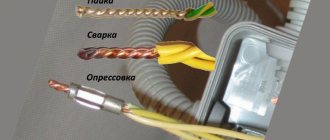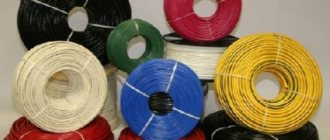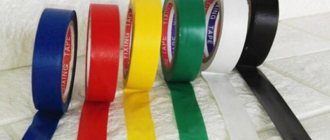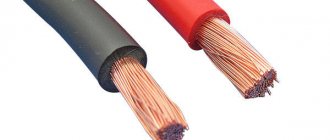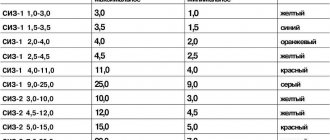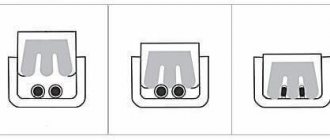In residential buildings that were built in Soviet times, electrical wiring was carried out with aluminum wires. Professional electricians prefer to make a modern household network with copper wires. Therefore, whether we like it or not, we often have to face the problem of how to connect copper and aluminum wire. Don’t listen to those who tell you that you absolutely can’t do this. Of course, not all methods are suitable for this case, however, connecting electrical aluminum and copper wires is a completely solvable task. The main thing is to do everything correctly.
These two metals have different chemical properties, which affects the quality of their connection. But there were smart heads who figured out how to connect two conductors, while eliminating direct contact between them.
We will look at all existing options for how you can connect copper and aluminum wires, but first, let's figure out why this cannot be done with ordinary twisting and what is the reason for this incompatibility?
Reasons for incompatibility
The main reasons for the undesirable connection between these two metals lies in the aluminum wire.
the result of twisting copper and aluminum is overheating of the connection, melting of the insulation, the possibility of fire
There are three reasons, but they all lead to the same result - over time, the contact connection of the wires weakens, begins to overheat, the insulation melts and a short circuit occurs.
- Aluminum wire has the ability to oxidize when exposed to moisture in the air. This happens much faster when in contact with copper. The oxide layer has a resistivity value greater than that of the aluminum metal itself, which leads to excessive heating of the conductor.
- Compared to copper conductor, aluminum is softer and has lower electrical conductivity, due to which it heats up more. During operation, the conductors heat up and cool down many times, resulting in several cycles of expansion and contraction. But aluminum and copper have a large difference in the magnitude of linear expansion, so a change in temperature leads to a weakening of the contact connection, and weak contact is always the cause of strong heating.
- The third reason is that copper and aluminum are galvanically incompatible. If you twist them, then when an electric current passes through such a unit, even with minimal humidity, a chemical electrolysis reaction will occur. This, in turn, causes corrosion, as a result of which the contact connection is again broken, and as a result, heating, melting of the insulation, short circuit, and fire.
Video
There are many videos showing how to connect copper and aluminum into a single network without compromising safety . They are useful for both beginners and experienced professionals who are ready to learn from other people’s experiences and learn outside opinions.
Recommended viewing:
- Where are electrical circuit diagrams used...
- All about current strength in physics
- How and with what to charge a li-ion (Li-po) battery?…
- How to make a TV antenna with your own hands
- How to check battery charge with a multimeter
- How to properly install HDM on the ceiling?
8+
Bolted connection
Bolted connection of aluminum wires to copper is considered the most affordable, simple, fast and reliable. To get started you will need a bolt, a nut, some steel washers and a wrench.
Of course, it is unlikely that you will be able to use this method to connect wires in an apartment junction box, because now they are produced in miniature sizes, and the resulting electrical unit will be very bulky. But if there are still Soviet-era boxes in your house or when you need to make a connection in a distribution panel, then this bolted method is best suited. In general, it is considered an ideal option when it is necessary to connect completely incompatible conductors - with different cross-sections, made of different materials, multi-core with single-core.
It is important to know that using the bolt method you can connect more than two conductors (their number depends on how long the bolt is long enough).
You will need to do the following:
- Strip each connected wire or cable from the insulating layer by 2-2.5 cm.
- From the stripped ends, form rings according to the diameter of the bolt so that they can easily be put on it.
- Now take the bolt, put a washer on it, then a ring of copper conductor, again a washer, a ring of aluminum conductor, a washer and tighten everything securely with a nut.
- Insulate the connection using insulating tape.
The most important thing is not to forget to place an intermediate washer between the aluminum and copper wires. If you will connect several different conductors, then you do not need to place an intermediate washer between the cores of the same metal.
Another advantage of this connection is that it is detachable. At any time you can unwind it and, if necessary, connect additional wires.
How to properly bolt a wire connection is shown in detail in this video:
Soldering and welding
Soldering wires allows you to get a fairly high-quality and permanent connection. However, when connecting aluminum wires, you should be aware of the presence of an oxide film on them, due to which the solder will not adhere very well.
To prevent such a defect from occurring, you need to follow a certain sequence of actions:
- The connected sections of wires are treated with a special flux, which removes the oxide film from the surface.
- The solder is processed as carefully as possible so that it has the largest area of contact with the wires.
- When the connection area has cooled , it is advisable to treat it with sandpaper to remove sharp edges that could damage the insulating layer.
- Wires must be insulated.
Soldering requires certain skills.
It should be said that this method has several negative aspects:
- He has to be isolated.
- The method itself is quite complicated , especially if you have to solder wires under the ceiling while standing on a stepladder.
- If an error was made during the work , then correcting it will be quite problematic.
- A lot of time is spent on work.
Welding is somewhat reminiscent of soldering wires, but it is much faster. In order to obtain a high-quality connection, the electrode is brought to the connection area for only 1-2 seconds. Both ends of the wire are pre-treated with flux to remove the oxide film.
If you have no experience in this area, then you should initially practice on twists prepared in advance, but not connected to the system.
After completing the welding process, the twists are treated with a special solvent and varnished. The result is a high-quality connection that can last for a long period of time, since this method helps prevent overheating. Accordingly, such an area will need to be isolated.
Walnut clip
Another good way to connect copper and aluminum wires is to use nut clamps. It is more correct to call this device a branch compressor. It was already the electricians who nicknamed it “the nut” because of its external resemblance.
It is a dielectric polycarbonate housing, inside of which there is a metal core (or core). The core is two dies, each of which has a groove for a certain cross-section of the conductor, and an intermediate plate, all of which are connected to each other with bolts.
Such clamps are sold in any electrical goods store; they have different types, which depend on the cross-section of the wires being connected. The disadvantage of such a device is that it is not sealed, that is, there is the possibility of moisture, dust and even small debris getting in. For reliability and quality of connection, it is better to wrap the “nut” with insulating tape on top.
The process of connecting wires using this compression is as follows:
- Disassemble the compression housing; to do this, pry up and remove the retaining rings using a thin screwdriver.
- On the wires to be connected, strip the insulating layer to the length of the dies.
- Unscrew the fixing bolts and insert the exposed conductors into the die grooves.
- Tighten the bolts, position the die in the compression housing.
- Close the housing and install the retaining rings.
A practical example of using a nut clamp is shown in this video:
Types of lubricants
For fixed static contacts (bolt, clamp, crimped, etc.), the lubricant acts as a sealant and sealant. Its main function is to displace moisture, protect the connection from external factors and ensure sufficient electrical conductivity.
Lubrication also ensures that the bolts are always tight and can be disassembled. There are no special requirements for antifriction performance for such pastes. The composition is characterized by increased thermal conductivity and is often used as a coolant for contact threaded connections of semiconductor parts and cooling radiators.
Lubricants for switching contacts (connectors, plugs, plugs, switches, etc.) are subject to increased requirements for adhesiveness and heat resistance. The lubricant must be firmly held on the surface and not rub off when opened. Also, at the moment of opening, especially at high currents, a short-term arc occurs, and the paste layer must not only withstand its temperature, but also protect the contact from burning.
Paste for sliding contacts subject to periodic or constant friction, in addition to electrical conductivity, must provide high antifriction performance. Be resistant to high temperatures that may occur during sparking. An important characteristic is also the adhesiveness of the paste and abrasion resistance. This is especially important when working on rotating surfaces at high speeds (in commutator motors).
All electrically conductive lubricants have low fluidity and evaporation requirements. This ensures a long period of their operation and reduces the frequency of maintenance.
Terminal block
A cheap and simple solution to the question of how to connect aluminum wires to copper wires is the use of terminal blocks. Buying them now is not a problem at all; moreover, you can buy not a whole section, but ask the seller to cut off the required number of cells. Terminal blocks are sold in different sizes, depending on the cross-section of the conductors connected to them.
What is such a block? This is a transparent polyethylene frame designed for several cells at once. Inside each cell there is a brass tubular sleeve. From opposite sides, the ends of the wires to be connected must be inserted into this sleeve and clamped with two screws.
The use of terminal blocks is very convenient because you can always cut off exactly as many cells from it as there are pairs of wires that need to be connected, for example, in one junction box.
Using the terminal blocks is very simple:
- Unscrew one clamping screw, thereby freeing one side of the sleeve for the conductor to pass into it.
- On the cores of the aluminum wire, strip the insulation to a length of 5 mm. Insert it into the terminal, tighten the screw, thereby pressing the conductor to the sleeve. The screw should be tightened firmly, but do not force it too hard, so as not to break the core.
- Do the same operations with the copper wire, inserting it into the sleeve from the opposite side.
Why do you have to do everything one by one? You can immediately unscrew two screws, insert the wires and tighten them. This is done to ensure that the copper and aluminum wires do not touch each other inside the brass sleeve.
As you can see, the advantages of terminal blocks are their ease and speed of use. This connection method is a detachable one; if necessary, you can remove one conductor and replace it with another.
Terminal blocks are not entirely suitable for connecting stranded conductors. In order to do this, you must first use ferrules that will crimp the bundle of cores.
There is one more feature in the use of terminal blocks. Under screw pressure at room temperature, aluminum can flow. Therefore, periodic inspection of the terminal and tightening of the contact connection where the aluminum wire is fixed will be required. If this is neglected, the aluminum conductor in the terminal block will become loose, the contact will weaken, begin to heat up and spark, which may result in a fire.
How to connect wires using a terminal block is shown in this video:
The impossible is possible, or how to connect copper and aluminum wire
While some doubt whether it is possible to connect aluminum wires to copper, many do it successfully. Moreover, there are a number of main generally accepted methods, thanks to which it is possible to eliminate contact between materials that act aggressively towards each other. Each of them requires separate attention.
The terminal block for connecting aluminum and copper wires can be equipped with either a clamping or bolt mechanism
How to Connect Copper and Aluminum Using Terminal Blocks
The terminal block for connecting wires can be equipped with a clamping or bolt mechanism. This design provides connection to two types of materials - aluminum and conductive. They contact each other through a steel plate. It is made from a neutral material that is not inclined to react with aluminum - often these are plates made of brass or tinned copper.
The wire block containing a bolt clamp is characterized by greater reliability and is used in low-voltage power circuits. Often this clamping is done using a “nut”. It is a small junction box made of dielectric materials. The device received this name due to its shape. Inside it there is a block of metal plates, through which contact is ensured between copper and aluminum wires.
Each of the above methods is a detachable connection. This means that, if necessary, you can repeatedly disconnect and connect them.
Note! Replacing the old wiring is recommended in any case. Copper has a load capacity that corresponds to the consumption of electrical devices. If it is not possible to perform a total replacement, it is carried out partially. Then the question arises of how to connect the wires correctly.
The most widely used terminal block for connecting wires is
The wire connection terminal, which is most widely used, is capable of connecting up to eight conductors with different cross-sections, and also allows you to attach it to a DIN rail using a special mounting adapter.
Features and secrets of using the crimping method
Sometimes in the process of installing and laying electrical wiring, the need arises to obtain a high-quality connection of wires. In this case, the connection of aluminum wires with copper is carried out by crimping using sleeves. Often, such a need appears at the stage of entry into electrical cabinets, switchgear, or when connecting a cable to an already installed unit, where there is no possibility of replacing copper with aluminum, and vice versa.
The presented type of conductor connection is characterized by high costs, since it involves the use of specialized equipment and tools. At the same time, in the process of performing repeated similar work, professionals often prefer this method.
Important! It is not recommended to fold conductors made of copper and aluminum in a direction parallel to each other, in other words, overlapping. The fact is that in such a case, copper and aluminum are in direct contact. In addition, it is better to avoid using bare copper sleeves in combination with a cable made of aluminum.
A reliable connection of aluminum wires with copper can be obtained using the crimping method using sleeves
By crimping the wires with sleeves, a more durable and reliable contact is guaranteed. In a similar way, aluminum and copper conductors are fastened in production even with powerful consumers.
To perform such work, special aluminum-copper sleeves will be required. If a manual hydraulic press is not available, they can be compressed using a standard hammer and aluminum pads.
This is interesting! It is recommended to use such compression when performing crimping not only with sleeves, but also with tips. By the way, they can also be made half of aluminum and copper. This allows you to connect the aluminum wire to various devices with terminals or leads made of copper.
Often, aluminum-copper sleeves are used to connect cable cores that have a large cross-section. If the cross-section is insignificant, a pair of conductors is crimped with a single sleeve. In this case, it is better to run the wires end-to-end - on both sides.
Crimping of cable cores with a small cross-section is carried out with one sleeve
A few words about the rules for bolting wires
Often, when working with electrical wiring at home, a person who is not involved in specific work may wonder how to reliably connect aluminum and copper wires. Naturally, in such a situation, there is no point in running to the market in order to purchase special tools. This is explained by the fact that the work is one-time in nature, but it is still necessary to complete it.
In such a case, a regular nut with a couple of washers and a simple bolt may well be used. In this method, the main thing is to separate two metals that are aggressive towards each other using washers.
Note! If you decide to give preference to a bolted connection, the steel washer can be replaced with a part made of brass. If you have metal at hand, you can even cut it out yourself. As for the option with a washer made of steel, it can only be used in those networks where the load is not too great.
Connecting copper wires to aluminum wires using a bolted method can be done in junction boxes. Without such structures it is impossible to imagine wiring, either in houses or in individual apartments. Thus, using a bolt, you can quickly and easily solve the question of how to connect stranded and single-core copper wire.
The connection of aluminum and copper wires by bolting can be carried out even in junction boxes
In a bolted connection, the rings formed from the wire must be screwed in the direction the nut is tightened. This is necessary in order to avoid unwinding of the rings and increasing their diameter during tightening. On the contrary, this method will promote a tighter turn around the bolt.
In addition, there is the option of using aluminum-copper washers and tips. There are several ways here:
- Crimp the aluminum cable using a lug and connect it to a busbar made of copper.
- Crimp a cable made of aluminum with a standard aluminum lug and connect to the bus using this washer.
How to connect copper to aluminum using the threaded method
Connecting wires using nuts and screws, if done correctly, is the most reliable solution and ensures proper contact throughout the entire life of the electrical wiring. The answer to the question of whether it is possible to connect copper and aluminum wires of different types using a threaded connection is a definite “yes”. Using a threaded connection, you can work with thick, single-core, thin, and multi-core wires. The main thing is to prevent direct contact between wires made of aluminum and copper.
Before connecting wires using a threaded method, you need to clean the metal until it shines and form rings
Before connecting electrical wires using a threaded method, you have to carry out preparations: remove the insulation from the conductors to a length equal to four times the diameter of the screw, in case of oxidation of the wires, clean the metal until the metal shines, and also form rings.
After this, the screw is ringed in the following order:
- spring washer;
- simple washer;
- ring of one conductor;
- simple washer;
- ring of another conductor;
- washer;
- screw.
When screwing the screw into the nut, the whole package is tightened until the spring washer straightens.
For conductors in which the core diameter does not exceed 2 mm, an M4 type screw will be sufficient. If the copper wire is stranded, first of all it is necessary to tinning it using solder.
Bolting wire connections is the most reliable solution
How to connect an aluminum wire to an aluminum one-piece method
The permanent type connection is endowed with all the advantages of a threaded type. The difference is only in a few points:
- the ability to disassemble and reassemble connections without disturbing the rivet;
- the need for special devices to carry out riveting.
Today, rivets have found wide application for permanent connections of thin-walled structural elements in the process of creating partitions. Efficiency, low price and strength are the main advantages of the presented type of permanent connection.
The essence of the functioning of the riveter is quite simple. It draws in and cuts steel rods threaded through a tubular rivet with a head made of aluminum. The rods are thickened, and as the rivet is pulled into the tube, it expands.
Using a riveter you can make not only permanent connections of thin-walled elements, but also reliably connect electrical wires
Note! There are rivets of different types, diameters and length variations. Therefore, everyone can choose the best option for performing personal tasks.
To connect conductors using a rivet, you will need to prepare them in the same way as for a threaded connection. The diameter of the rings should be slightly larger than the diameter of the rivet. The optimal size is 4 millimeters. The parts are put on the rivet in the following order:
- aluminum conductor;
- spring washer;
- copper conductor;
- flat washer.
Then a steel rod is inserted into the rivet gun and its handles are pressed until it snaps into place. This sound indicates that excess steel bars are being trimmed. That's it, the connection is complete.
Related article:
Connecting wires in a junction box for electrical wiring
Types and methods of installing distribution boxes. How to install it yourself.
The degree of reliability of both one and the second type of connection presented using a rivet is quite high. A similar connection method can be successfully used to splice damaged areas during the repair of conductors in the wall. However, it is imperative to ensure excellent insulation of the exposed joints.
Since rivets come in different types, diameters and lengths, everyone can choose the right option
How to connect aluminum wires using soldering
In the case of a large conductor cross-section (when mass is more important than strength), it would be rational to give preference to aluminum. The cross-sectional area of a wire made of aluminum will be several times larger compared to copper, and the aluminum part will still be twice as light as a copper one. If you ask people how to connect copper wires to each other, many will answer that it is better to do this by soldering.
You can solder wires made of aluminum in a junction box using a gas torch or soldering iron. The difficulty with using a soldering iron is that it is almost impossible to accurately heat it to the desired temperature. And in the case of aluminum, overheating is just as unacceptable as underheating.
Important! The metal is characterized by significant thermal conductivity, and melting can occur over a wide area from the soldering point.
It should be remembered that soldering copper to aluminum is not possible
Therefore, before connecting aluminum wires to each other, so as not to heat up, it is better to arm yourself with a gas burner. With its help, it is easier to adjust the heating temperature, but to use it you will have to prepare the surface for a long time. Nevertheless, it is better to give preference to the torch if it is necessary to solder massive parts. Be that as it may, soldering aluminum wires involves preparing them.
The difficulty of the soldering process is that aluminum is characterized by low fusibility, so if heated carelessly it can melt. The essence of another factor due to which the soldering process becomes more complicated comes down to the rapid oxidation of aluminum in air.
Although oxide deposits on the surface are a reliable protection of aluminum from negative external conditions, it also inhibits the adhesion of the material to the solder, so it must be removed.
Note! It is not possible to remove oxide deposits mechanically. The material immediately oxidizes and is covered with film again. You can only get rid of it mechanically by covering the surface with an oil layer.
Before soldering, the ends of aluminum conductors must be treated with oil.
The option with oil is completely inconvenient at home, and is also labor-intensive. The oil must first be calcined to 200 degrees to rid it of the oxygen present in it.
Thus, before soldering, the ends of aluminum conductors should be treated. The use of rosin or many other fluxes will not be effective due to the high degree of chemical stability of the oxide deposit. It does not dissolve even if organic acid is applied.
Note! In order to carry out tinning of wires, fluxes specially designed for this purpose and the mechanical method should be used simultaneously.
Naturally, a similar procedure should be performed until the wires are twisted. Otherwise, it will not be possible to clean the entire surface of the wire. Only the ends that have been tinned can be twisted together and then soldered.
You can solder aluminum wires using a gas torch or soldering iron.
Wires equipped with several cores should be soldered exclusively using a special flux, since their mechanical processing is almost impossible. A special feature of the soldering technology is that each of the wires must first be thoroughly processed using flux.
To do this, you will have to untwist and fluff the bundle. After the processing is completed, each of the thin wires of the core will need to be covered with a layer of solder and twisted into a bundle. After this, several ends are twisted and soldered.
Important! Situations may often arise when it is necessary to connect wires made of different metals. It should be noted here that soldering aluminum to copper is not possible.
The whole problem lies in aluminum. Due to its chemical and physical properties, aluminum cannot be soldered to another metal. If you decide to solder copper and aluminum using solder that is neutral to both metals, the different coefficient of temperature expansion will quickly destroy the contact. This is explained by the fact that during the passage of current through the conductor, it will definitely heat up, and after disconnecting it will cool down, and nothing can be done about it.
Special fluxes are used for tinning wires.
Studying the question of how to connect aluminum wires to each other when laying power wiring, it becomes clear that a standard soldering iron and sandpaper will not cope here. Therefore, before connecting copper wires to each other, you will need to arm yourself with knowledge regarding the basic principles of welding.
However, if we are talking about connecting wires that are made of different metals, it is better to immediately discard the idea of welding. This is due to the difference in temperature required to melt the metals. And such a procedure will not protect you from destructive electrolysis at all.
Self-clamping terminals
It is even faster and easier to connect aluminum and copper conductors using self-clamping terminals.
The stripped conductors must be inserted into the terminal holes until they stop. There they will be automatically fixed with the help of pressure plates (it will firmly press the conductor to the tinned busbar). Thanks to the transparent housing of the terminal block, you can check whether the core has fully entered the terminal. The disadvantage of such devices is that they are disposable.
If you want a reusable clamp, use lever terminals. The lever rises and releases the entrance to the hole into which the stripped core must be inserted. After which the lever is lowered back, thereby fixing the conductor in the terminal. This connection is detachable; if necessary, the lever is raised and the wire is removed from the terminal.
Self-clamping terminals “WAGO” have proven themselves best in the electrical goods market. The manufacturer produces a special series of terminals that contain “Alu-plus” contact paste. This substance protects the contact junction between aluminum and copper from the manifestation of electrolytic corrosion processes. You can distinguish these terminals by the special marking on the packaging “Al Cu”.
Using such terminals is also extremely simple. The clamp itself indicates how long the insulating layer of the conductor needs to be stripped.
The advantages and disadvantages of using WAGO terminal blocks are described in this video:
Scope of application
The use of conductive pastes is provided for by regulatory documentation and is mandatory in most technological processes of the energy complex, power supply, installation and maintenance of electrical and electronic equipment.
Conductive paste is used to process:
- bolted and clamped contact connections;
- connecting blocks;
- cable lugs and sleeves before crimping;
- detachable connections of electrical equipment;
- switch knives and fuse holders;
- starters and relays;
- electrical receiving brushes and commutators;
- slide switch parts;
- spark plug contact parts;
- twists under the PPE cap when installing lighting equipment.
Treatment with conductive lubricants eliminates the use of additional seals and losses due to contact resistance, increases the efficiency of distribution systems, reduces maintenance costs and extends the service life of equipment.
Twist connection
Twisting of copper and aluminum wires is not recommended. If you cannot do without this, then first you should tin the copper conductor, that is, cover it with lead-tin solder. This way you will eliminate the possibility of direct interaction between aluminum and copper.
Do not forget that aluminum is very soft and brittle and can break even under minor loads, so twist it very carefully. Do not forget to properly insulate the connection; in this case, it is best to use heat-shrinkable tubing.
We tried to tell you in detail whether it is possible to connect wires made of aluminum and copper, as well as how to do this efficiently and reliably. Choose the most suitable method for yourself, depending on where this connection will be switched and operated.
Adapters for connecting from aluminum to copper
Sleeve adapters for crimping are considered the most reliable and high-quality connection. Special copper-aluminum models are made, into which 2 wires are inserted, after which they are processed with a press. However, it should be noted that the sleeves require sections starting from 16 mm2, while in residential buildings from 1.5 to 4 mm2 are used. Therefore, it is better to connect using a standard aluminum sleeve. Pressure testing occurs according to the following algorithm:
- We strip the ends of the copper conductor with lead-tin solder - this helps prevent metal-to-metal contact.
- Get rid of aluminum oxide film.
- Pass the wires through from different ends and crimp them.
- Wrap the connections with electrical tape or heat shrink followed by heating.
Important! If excessive crimping is done inside the structure, the soldered layer at the copper end may be damaged, so the size of the sleeve and matrix must match the core.
The good thing about the adapter from aluminum to copper is that it can be embedded under the plaster without fear of the wiring catching fire. However, implementation will require a press, which entails certain costs.
Sleeves
It is recommended that when carrying out work, all electrical wiring is intact, without breaks or connections - this reduces the risk of fire. However, if there is an urgent need to join a copper and aluminum core, then you need to take into account all the recommendations and choose one of the most optimal methods.
Advantages of aluminum wiring
Although in fairness, an alternative point of view should be considered. Some people don’t see anything at all in this order.
Quite the contrary.
After all, no one in this document prohibits the use of copper.
It’s just that from now on there is a legitimate opportunity to save and reduce costs where appropriate. It may be that in some cases it is really convenient to lay a thicker, but cheaper aluminum wire.
In this case, it is natural to take into account all the loads. Moreover, this will create competition in this area, as a result of which copper may become cheaper.
In addition, copper reserves are not as inexhaustible as many people think. Therefore, searching for an alternative is more than appropriate.
So, of course, you will have to decide on your own which copper or aluminum alloy cable to use at your facilities. The main thing is that now you have been given the legal choice to apply this or that decision.
Features of the use of connections for external and internal work
nut clamp
All of the listed methods for connecting conductors of dissimilar metals are intended for the internal electrical network. For outdoor work, it is better to use a special plastic clamp “Nut”.
The plastic body of the clamp contains several metal plates. The clamp body is tightened with special screws and reliably protects the connection point from contact with the environment. As a rule, external electrical networks are not as critical of connection dimensions as they are indoors, so connections with the “Nut” clamp are a pretty good option.
It must be borne in mind that conductor connections, no matter what they are, are prohibited from being tightly sealed in walls, ceilings, etc., much less hidden under a layer of plaster. Only special distribution boxes should be used.
Methods for connecting different wires
How to connect copper and aluminum wires:
- using another metal;
- preventing the appearance of harmful oxide plaque.
In the second case, special compounds are used that can protect the metal from the effects of moisture and oxidation. Pastes prevent the connection from breaking down. Another method of fire protection is tinning. Tinned stranded cable can be twisted with single-core aluminum cable. Special devices are also used for connection:
- Clamps. Used to connect to an aluminum riser in the driveway panel. Branch clamps have punctures or lack them. The device is equipped with an intermediate plate that prevents contact between two metals. Some clamps are treated with paste. Sometimes the use of special compounds is not required.
- Spring and self-clamping terminal blocks. Wires made of different metals can be joined and spliced using terminals that have sockets and partition plates that separate the aluminum conductors from the copper ones.
- Bolts. When making a bolted connection, a stainless or galvanized steel washer is placed between the wires.
Terminal blocks
Terminal blocks are:
- Disposable. Used when connecting wires in junction boxes and installing chandeliers. To insert the cores into the hole of the device, you need to make an effort. Even more difficult is removing the cable from the block.
- Reusable. There is a lever for fixation, thanks to which the cable can be inserted and removed several times. Terminals of this type are used when connecting stranded wires made of different metals. If the work is done incorrectly, the connection can be redone.
Installation is carried out as follows:
- the cable is cleared of its insulating coating;
- the veins are cleaned to a metallic shine;
- a lever rises on the reusable terminal block;
- the cleaned part of the wire is inserted into the hole in the block until it stops;
- the lever returns to its original position.
Crimping
In this case, tubular sleeves are used to reliably and safely fasten the wiring elements. To connect the cables you will need a press, mechanical, hydraulic or electric pliers. Installation includes:
- sleeve selection and tool adjustment;
- cleaning wires from braid;
- stripping the cores (sandpaper is used for this);
- application of quartz-vaseline composition;
- inserting the ends of the cables into the rivet;
- crimping (when using a simple tool, several crimps are performed over a short distance; when using a good tool, crimping is performed once);
- insulation of connection points.
The wires are inserted into the sleeve from opposite sides so that the joint is located in the middle of the connector. The cores can be inserted from one side. Connecting cables with a sleeve is sometimes replaced by using nut clamps, but the latter are less reliable. Over time, the rivet weakens, increasing the risk of fire.
Bolted connection
If the installation rules are followed, the method ensures durable fastening. To complete the work you will need 2 simple washers, 1 spring washer, a nut and a bolt. The wires are cleared of insulating material. The spring washer is placed on the bolt, which is inserted into a simple washer. The end of the aluminum cable is folded into a ring, which is thrown onto the bolt. After this, put on a simple washer and screw on the nut. Before starting work, the stranded wire is covered with solder.
Soldering
This is a reliable and technologically advanced method that ensures a high-quality connection. Before soldering, the conductors are cleaned of braid and oxide film. If necessary, the cables are tinned, loosely twisted, treated with flux and soldered. It is impossible to connect aluminum and copper wires using acid flux. The composition destroys metals, reducing the strength of the fastening. The junction is isolated in the usual way.
Connection via bolt and steel washers
This is one of the most proven and simple methods. The truth is that it turns out to be a very large design. For installation, twist the ends of the wires into rings. Next, select the washers.
They must be of such a diameter that the entire eye of the wire is hidden behind them and cannot contact another conductor.
The most important thing is how to position the ring. It must be put on so that when tightening the nut, the eye does not unfold, but rather is pulled inward.
Steel washers between conductors made of different materials prevent oxidation processes. In this case, do not forget about installing the engraver or spring washer.
Without it, contact will weaken over time.
It should be especially noted that it is not recommended to use galvanized bolts or washers.
The fact is that metals whose electrochemical potential of the connection does not exceed 0.6 mV can be safely connected to each other.
Here is a table of such potentials.
As you can see, copper and zinc have as much as 0.85 mV here! This connection is even worse than direct contact between aluminum and copper conductors (0.65 mV). This means the connection will not be reliable.
However, despite the simplicity of the threaded assembly, the end result is a large, awkward structure, shaped like a beehive.
And it’s not always possible to stuff this whole thing into a shallow socket. Moreover, even in such a simple design, many manage to screw it up.
The consequences will not keep you waiting in a very short time.


